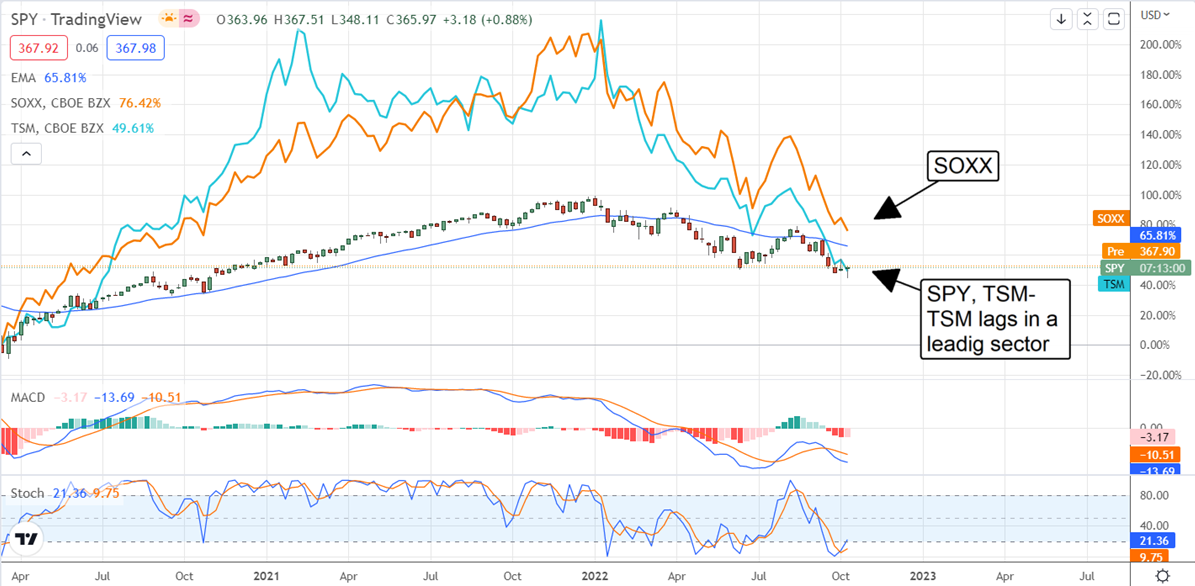- Taiwan Semiconductor is the world's largest semiconductor foundry and is fundamental to the entire complex.
- The stock trades at a deep discount to the broad market and pays a 2.8% dividend yield.
- Near-term headwinds may impact results over the next quarter or more but long-term trends point to a rebound in 2023.
As the world’s first and largest pure-play on semiconductor foundry/manufacturing Taiwan Semiconductors (NYSE:TSM) may be the single best individual investment in the semiconductor space. The company does not make or market its own product, it manufactures semiconductors for suppliers ranging from Apple (NASDAQ:AAPL) to Nvidia (NASDAQ:NVDA) and just about every fabless semiconductor company on the market. In this light, the company is exposed to the semiconductor industry and not one sector, segment, or industry and so also gives ample diversification. Add in the low 10X earnings multiple and the dividend which is yielding close to 2.8% and the stock looks very buyable. The caveat is that there are some factors in play that may make waiting to buy a better option.
Signals From The Industry Point To Changing Times
Signals from within the industry suggest the semiconductor industry is approaching a turning point. Commentary from Nvidia, Micron (NASDAQ:MU), and Apple (TSM’s largest customer) suggests that a peak has been reached in the existing microchip market, a peak driven by pandemic demand and undercut by the post-pandemic economic correction and rising semiconductor inventories, but the market is also set up for another boom that could begin in 2023.
In regards to Apple, Bloomberg reported the company told its suppliers to back off a previously announced boost to iPhone 14 production and to slow down the production of components for other models as well. Micron says the memory-chip market is undergoing an inventory-led correction and Nvidia is suffering from slowing game console and PC demand. The latest news from Gartner is that PC shipments plunged nearly 20% in Q3 marking the steepest decline in two decades and the takeaways are not good. Near-term headwinds are pinching demand for finished goods and that is having an impact on demand for microchips nearly across the board. The one area of strength that has been repeated more than once is that demand for data center and cloud semiconductors are still strong.
The most recent and shocking news from a major Taiwan Semiconductor client comes from Advanced Micro Devices (NASDAQ:AMD). The company warned its Q3 revenue would come in about 16% below the prior forecasts and that margins would be impacted as well. The reason is PC demand and “continued inventory corrections”. Not good news for Taiwan Semiconductors not one bit but the news is not all bad. The inventory correction is allowing not only Taiwan Semiconductors but the chip industry at large to focus on the next generation of chips, many of which are already in production or on the books to do so.
The Analysts See Value In Taiwan Semiconductor
Marketbeat.com is tracking 8 analysts with current coverage of Taiwan Semiconductor and they see great potential in the stock. The consensus rating has been firming over the last year and is now a Moderate Buy verging on a firm Buy. The most recent commentary is from Goldman Sachs which lowered its rating from Conviction Buy to Buy but gave no price target. The consensus price target, however, is down a little on a YOY basis but more steady than not at $120 which is 80% above the current price action. The analysts may bring their targets down and that may weigh on price action in the near term but they’d have to cut their targets nearly in half to bring them in line with recent price action and the outlook for the business long term is good.
Turning to the chart, the stock is well off of its highs and showing signs of a bottom but it is too soon to call one now. Factors in favor of bottoming include the lower wick on the current but not closed weekly candle, a mild divergence in MACD, and a bullish crossover in the stochastic. These may result in a rebound or bounce but the trend is still down so investors should expect range-bound trading or at least a retest of support if a bottom forms now.

